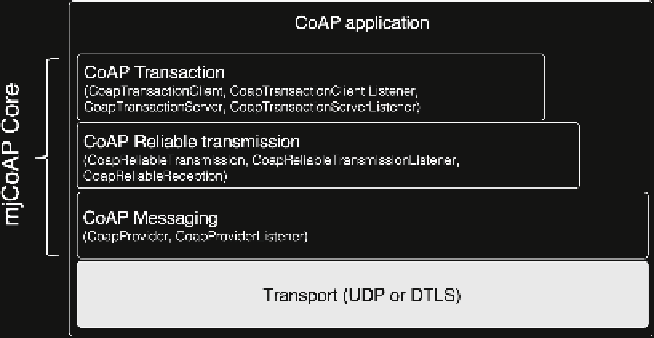Database Reference
In-Depth Information
oranumberof
MAX RETRANSMIT
retransmissions is reached, according to
the CoAP standard; in both cases the user of the
Reliable transmission
layer
is informed of the result of the transmission, that is whether the message has
been received by the remote entity (confirmed by the
ACK
), or a transmission
failure (transmission timeout) has occurred. Similarly, at the server side, the
Reliable transmission
is responsible of receiving and processing
CON
messages
and automatically sending the corresponding
ACK
messages; according to
RFC 7252, both separate and “piggybacked” responses are supported; in the
latter case, the
Reliable transmission
layer is also responsible of sending the
piggybacked responses.
-
Messaging
- It is the sublayer that is responsible for sending and receiving
single CoAP messages, regardless they are requests or responses,
CON
,or
NON
,
ACK
,or
RST
messages.
Under the
Messaging
sublayer, there is the standard transport protocol (UDP
or DTLS).
Fig. 1.
mjCoAP stack architecture.
The
Transact ion
layer is implemented by the mjCoAP classes
CoapTrans-
actionClient
and
CoapTransactionServer
, and the corresponding listening inter-
faces
CoapTransactionClientListener
and
CoapTransactionServerListener
,used
for intercepting transaction events (e.g. at the client-side, the reception of a
response within a CoAP transaction). The
Reliable transmission
layer is imple-
mented by the classes
CoapReliableTransmission
and
CoapReliableReception
,
and the listener interface
CoapReliableTransmissionListener
. Finally, the
Mes-
saging
layer is implemented by the class
CoapProvider
and the listening inter-
face
CoapProviderListener
. Within the
Messaging
layer, the following classes has
been also defined: (i)
CoapMethodId
; (ii)
CoapTransactionId
and
CoapReliable-
TransmissionId
, which extend the abstract class
CoapId
, and that are used for

Search WWH ::

Custom Search